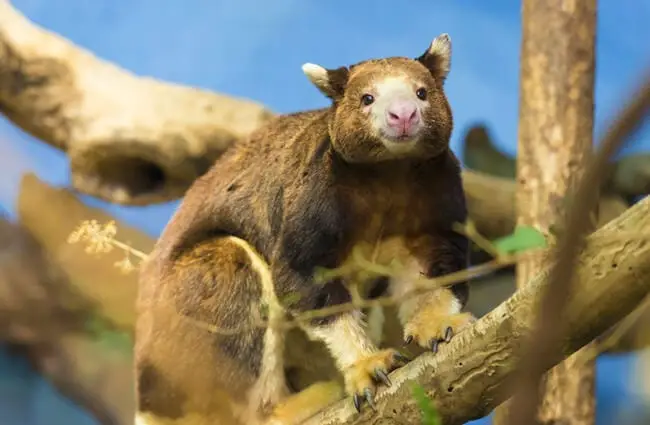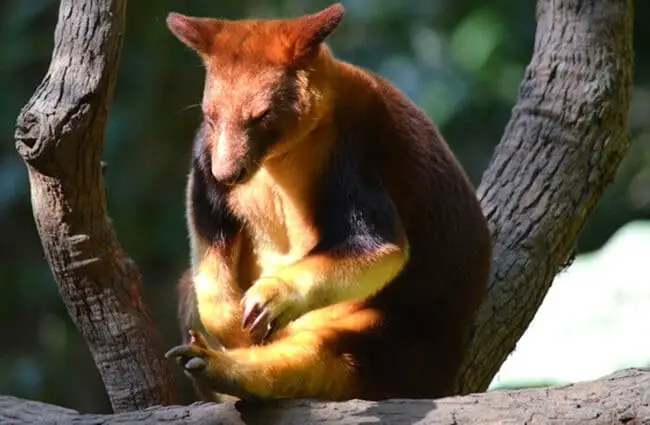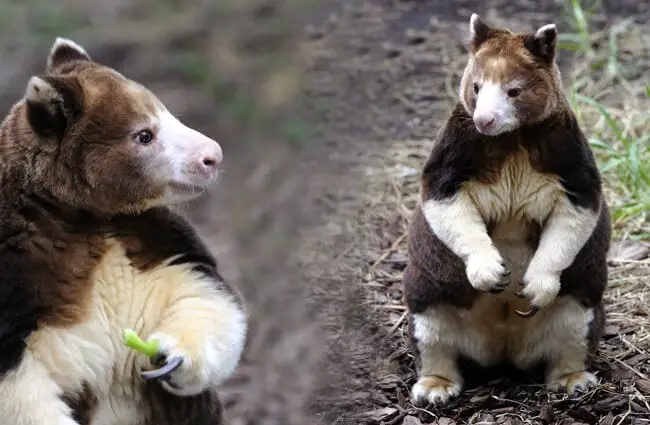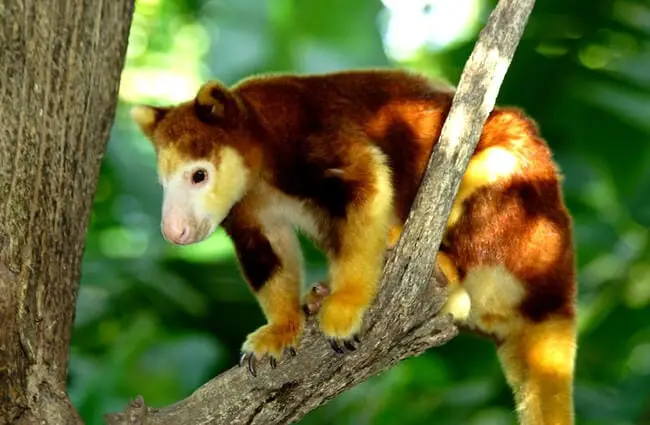Unveiling the Enigmatic Tree Kangaroo: A Marvel of Arboreal Adaptation
Imagine a kangaroo, but instead of bounding across the Australian outback, it’s gracefully navigating the dense canopy of a rainforest. This isn’t a whimsical dream, but the reality of the tree kangaroo, one of nature’s most captivating evolutionary success stories. These unique marsupials have traded the open plains for the high branches, developing an array of specialized adaptations that allow them to thrive in an arboreal world. Join us on a journey to discover the fascinating life of the tree kangaroo, from its hidden habitats to its vital role in the ecosystem, and what its future holds.

Where the Wild Things Are: Habitat and Distribution
Tree kangaroos are primarily found in the tropical rainforests of New Guinea, including its surrounding islands, and a small region of northeastern Queensland, Australia. Their preferred habitats are often dense, mountainous cloud forests, where they can find ample cover and food. These environments are characterized by high humidity, abundant rainfall, and a rich diversity of plant life, providing the perfect setting for these specialized herbivores.
For the aspiring animal lover hoping to spot one in the wild, be prepared for a challenge. Tree kangaroos are masters of camouflage and are predominantly nocturnal, making them incredibly elusive. Locating them requires patience, keen observation skills, and often the guidance of experienced local trackers. They typically rest during the day high in the tree canopy, often curled up on a branch or hidden amongst dense foliage. Their presence is more often indicated by their droppings or feeding signs than by direct sightings.
Acrobats of the Canopy: Physical Characteristics and Adaptations
Unlike their ground-dwelling cousins, tree kangaroos possess a suite of physical traits perfectly tailored for life in the trees. They are generally smaller and stockier than terrestrial kangaroos, with powerful forelimbs equipped with long, curved claws that provide an excellent grip for climbing. Their hind legs are shorter and broader, allowing for strong propulsion upwards and agile maneuvering on branches, rather than the powerful hopping seen in ground kangaroos.
Perhaps their most distinctive feature is their long, muscular tail, which can be as long as their body. This tail acts as a crucial counterbalance, aiding in stability as they leap between branches or navigate precarious perches. While not prehensile, it is an indispensable tool for arboreal locomotion. Their feet are broad and padded, with rough soles that enhance traction, much like a built-in climbing shoe. Their dense, often beautifully patterned fur provides excellent camouflage against the dappled light of the forest canopy, helping them blend seamlessly with their surroundings. Species like the Goodfellow’s tree kangaroo, for instance, are known for their striking reddish-brown fur and golden stripes.

The Leafy Buffet: Diet and Foraging Behavior
Tree kangaroos are primarily herbivorous, with a diet consisting mainly of leaves, fruits, flowers, and bark. They are selective feeders, often preferring young, tender leaves and specific types of fruits available in their rainforest habitat. Their digestive system is specially adapted to process tough, fibrous plant material, much like other herbivores. While their diet is predominantly plant-based, there have been rare observations of them consuming birds’ eggs or small invertebrates, suggesting an opportunistic streak when resources are scarce.
Foraging typically occurs at night, when they move through the canopy, carefully selecting their meals. Their strong sense of smell helps them locate ripe fruits and preferred foliage. They often feed alone, a reflection of their generally solitary nature, ensuring minimal competition for resources within their territory.
From Pouch to Canopy: Mating and Reproduction
Tree kangaroos are largely solitary animals, coming together primarily for mating. The reproduction process follows the typical marsupial pattern. After a relatively short gestation period, a tiny, undeveloped joey is born. This altricial newborn, often no larger than a jelly bean, immediately makes the arduous journey from the birth canal to the mother’s pouch, where it latches onto a teat.
The joey spends a significant period, often many months, developing within the safety and warmth of the pouch. During this time, it grows, develops fur, and its eyes open. Once it begins to emerge, it will gradually spend more time outside the pouch, initially clinging to its mother’s fur, before eventually becoming independent. The mother-joey bond is strong, with the mother providing extensive care and protection until the young tree kangaroo is ready to navigate the canopy on its own.

An Evolutionary Journey: From Ground to Tree
The evolutionary history of tree kangaroos is a compelling tale of adaptation. Scientists believe that these arboreal marsupials descended from ground-dwelling macropods, much like their terrestrial kangaroo relatives. Over millions of years, as their ancestors moved into forested environments, they underwent a remarkable evolutionary shift, developing the specialized features necessary for an arboreal lifestyle. This transition involved significant changes in limb structure, tail function, and even fur growth patterns, making them a prime example of adaptive radiation and ecological niche specialization.
This journey from ground to tree highlights the incredible plasticity of evolution, demonstrating how species can dramatically alter their morphology and behavior to exploit new ecological opportunities. Studying their evolution provides valuable insights into how environmental pressures can drive the development of unique traits and behaviors.
Guardians of the Forest: Ecological Role and Interactions
Tree kangaroos play a crucial, albeit often understated, role in their rainforest ecosystems. As herbivores, they influence forest vegetation structure through their feeding habits, helping to shape the distribution and abundance of certain plant species. More importantly, by consuming fruits, they act as significant seed dispersers. As they move through the canopy and deposit seeds in their droppings, they contribute to the regeneration and genetic diversity of the forest, effectively planting new trees and maintaining the health of their habitat.
Their interactions with other animals are generally limited due to their specialized niche. Predators in their environment include large pythons, birds of prey that might target young joeys, and occasionally dingoes or other native carnivores if a tree kangaroo descends to the ground. However, their arboreal lifestyle provides a degree of protection from many terrestrial predators. Their presence is an indicator of a healthy, intact rainforest ecosystem.

Tree Kangaroos and Us: Human Interaction and Conservation
Cultural Significance:
- In many indigenous cultures of New Guinea and Australia, tree kangaroos hold significant cultural value. They often feature in local folklore, myths, and traditional art, symbolizing the spirit of the forest or representing important ancestral connections. Their unique appearance and elusive nature have made them subjects of reverence and storytelling for generations.
Interaction in the Wild:
- For hikers or researchers fortunate enough to encounter a tree kangaroo in the wild, the best course of action is to observe from a respectful distance. These animals are shy and easily stressed by human presence. Avoid making sudden movements or loud noises. Never attempt to approach, touch, or feed a wild tree kangaroo. Such actions can habituate them to humans, disrupt their natural behaviors, and potentially expose them to harm or disease. Simply appreciate the rare privilege of witnessing these magnificent creatures in their natural habitat.
Conservation Status:
- Sadly, many species of tree kangaroos are facing significant threats, with several classified as endangered or critically endangered. The primary threats include habitat loss and fragmentation due to deforestation for logging, agriculture, and mining. Hunting for bushmeat and the pet trade also pose serious risks in some regions. Climate change, leading to altered weather patterns and increased frequency of extreme events, further exacerbates these challenges.
- Conservation efforts are underway, focusing on establishing protected areas, implementing sustainable land management practices, and engaging local communities in conservation initiatives. Captive breeding programs in zoos worldwide also play a vital role in maintaining genetic diversity and raising public awareness about these incredible marsupials. Protecting tree kangaroos means protecting the precious rainforests they call home.
Caring for Tree Kangaroos: Insights for Zookeepers
Caring for tree kangaroos in a captive environment requires specialized knowledge and dedication to replicate their natural conditions as closely as possible. Zookeepers play a crucial role in their welfare and conservation.
- Habitat Replication:
- Enclosures must be spacious and tall, providing ample vertical climbing opportunities with sturdy branches, ropes, and platforms at varying heights.
- Maintaining appropriate temperature and humidity levels, mimicking their tropical rainforest environment, is essential.
- Dense foliage, both live and artificial, should be provided for hiding, resting, and enrichment, allowing them to feel secure.
- Dietary Management:
- A specialized herbivorous diet is paramount, consisting of a wide variety of fresh, high-quality leaves (e.g., browse like ficus, hibiscus), fruits, and vegetables.
- Dietary supplements, particularly for vitamins and minerals, are often necessary to ensure complete nutrition.
- Regular monitoring of food intake, weight, and digestive health is critical to prevent nutritional deficiencies or obesity.
- Behavioral Enrichment:
- To stimulate natural behaviors, zookeepers employ various enrichment strategies. These include puzzle feeders that encourage foraging, introducing new climbing structures, and rotating items within the enclosure to keep the environment novel and engaging.
- Mimicking natural foraging patterns, such as scattering food or hanging browse, promotes physical activity and mental stimulation.
- Social Structure:
- Given their generally solitary nature, individual housing is often preferred, though pair bonding for breeding purposes requires careful introduction and monitoring.
- Understanding individual personalities and social dynamics is key to successful management.
- Health Monitoring:
- Regular veterinary checks, including physical examinations and diagnostic tests, are crucial for early detection and treatment of health issues.
- Zookeepers must be vigilant in observing any changes in behavior, appetite, or physical condition that might indicate stress or illness.
- What to Avoid:
- Sudden loud noises, excessive human traffic, or any disturbances that can cause stress to these shy animals.
- Inappropriate diets lacking essential nutrients or containing harmful substances.
- Lack of adequate climbing opportunities, which can lead to muscle atrophy and behavioral issues.
- Over-handling or forced interaction, which can be highly stressful and detrimental to their welfare.

Fascinating Facts About Tree Kangaroos
- There are approximately 14 recognized species and subspecies of tree kangaroos, each with unique characteristics and geographic distributions, such as the Matschie’s tree kangaroo, Goodfellow’s tree kangaroo, and Lumholtz’s tree kangaroo.
- Despite their somewhat bulky appearance, they are incredibly agile and can leap impressive distances, up to 9 meters (30 feet), between trees.
- Their fur often grows in a reverse direction on their backs, forming a natural part, which helps rainwater run off their bodies efficiently, keeping them dry in their wet rainforest environment.
- While sharing the “kangaroo” name, they are not as closely related to the large red or grey kangaroos as one might think, but rather belong to the macropod family, which also includes wallabies.
- They can descend trees headfirst, a rare feat for many arboreal mammals, thanks to their flexible ankle joints and strong claws.
- Some species, like the Wondiwoi tree kangaroo, are so rare they were thought to be extinct for decades before rediscovery.
- Tree kangaroos communicate through a variety of soft vocalizations, including hisses and growls, and also use scent marking to delineate territories.
The tree kangaroo stands as a testament to nature’s boundless creativity, a marsupial marvel that has mastered life in the treetops. From their unique adaptations for climbing to their vital role in seed dispersal, these creatures are integral to the health of their rainforest homes. As we continue to learn more about them, it becomes increasingly clear that their survival is intertwined with the preservation of these precious ecosystems. By understanding and appreciating the tree kangaroo, we take a crucial step towards ensuring that these acrobats of the canopy continue to thrive for generations to come.

![Red Angus Closeup of a beautiful Red Angus cowPhoto by: U.S. Department of Agriculture [pubic domain]https://creativecommons.org/licenses/by/2.0/](https://animals.net/wp-content/uploads/2020/03/Red-Angus-4-238x178.jpg)




![Red Angus Closeup of a beautiful Red Angus cowPhoto by: U.S. Department of Agriculture [pubic domain]https://creativecommons.org/licenses/by/2.0/](https://animals.net/wp-content/uploads/2020/03/Red-Angus-4-100x75.jpg)

